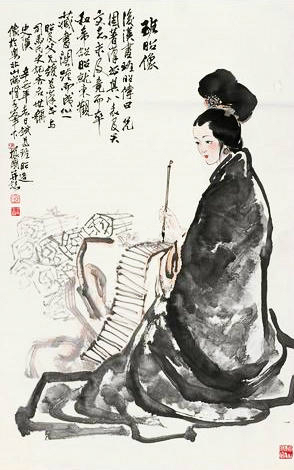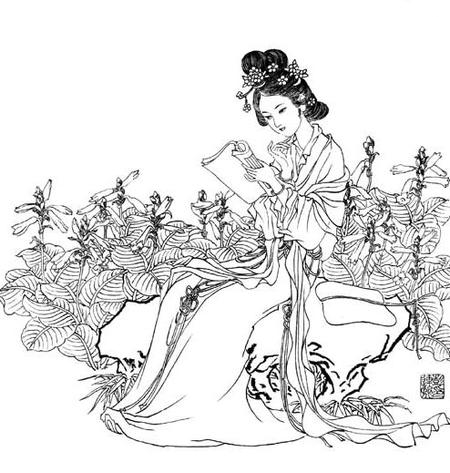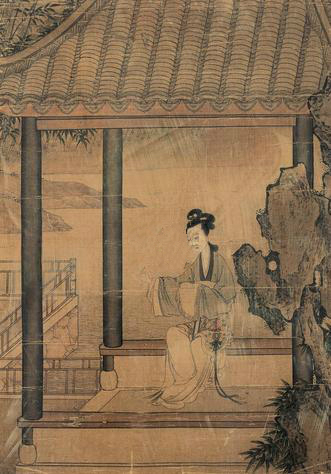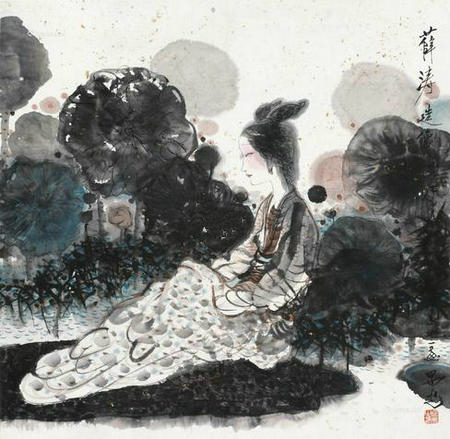Editor's note: March 8 marks the annual International Women's Day. Around the world, women usually played an obscure role in history. They were often buried with their unknown talents and amazing tales. Yet there are still some lucky ones whose stories have been recorded.
Here are six talented ancient Chinese women who once impressed in their time, and still affect us in our time.
A painting of Li Qingzhao, by Chen Zhenming. [Photo/artron.net]
Li Qingzhao
Praised as the "No.1 talented woman", Li Qingzhao, a poet from the Song Dynasty (960-1279), was born in Shandong province.
She excelled at poetry and in ink painting and calligraphy. She and her husband, Zhao Mingcheng, shared an interest in collecting bronze ware and headstones carved with prose and poems. Li was most well-known for her poems, which were divided into two contrasting styles reflecting her life as a married woman and a widow. Before Zhao's death, her poems were mainly about a carefree and happy life. The keynote turned into a tragic tune after Zhao passed away.
However, Li was not a narrow-minded woman. Apart from expressing feminine feelings and experiences, she also wrote poems praising war heroes and criticizing the decayed and weak emperor and royals.
One of her most famous poems is "Born as an outstanding soul, even die as a hero among spirits".
As an example of female patriot, Li has a great effect on modern women's literature.
A painting of Cai Wenji, by Bai Bohua. [Photo/artron.net]
Cai Wenji
Cai was good not only at poetry and calligraphy, but also mathematics, astronomy, debate and music. Her masterpieces wereHu Jia Shi Ba Pai, orEighteen Songs of a Nomad Flute, andBei Feng Shi, orIndignant Poems.
As the daughter of literatus Cai Yi of the Eastern Han Dynasty (25-220), Cai had a very unusual life. After her first husband died, Cai was abducted by theXiongnutribe, an ancient group in China. She was forced to marry the tribe's Zuoxian king and gave birth to two children. Living in a totally different environment, Cai was very homesick.
Twelve years later, warlord Cao Cao, also a student of Cai Yi, rescued Cai from theXiongnutribe. At the age of 35, Cai was married for a third time in a union arranged by Cao to a man named Dong Si.
A painting of Ban Zhao, by Chen Zhenguo. [Photo/artron.net]
Ban Zhao
Ban was the first female historian in China. Her father, Ban Biao, was an historian during the Eastern Han Dynasty. She was also good at writing poems, yet only seven of her works have survived.
Ban was often invited by the emperor to teach the queen and other concubines mathematics, astronomy and poetry. She was honored asDa Gu, a title for knowledgeable and noble women.
At the age of 40, Ban finishedHan Shu, orBook of Han, based on her brother's writings. A total of four people wrote the book, and Ban, as the last writer, faithfully kept the style of the first three.
Ban Zhao also wrote the famousNv Jie, a book to teach women how to properly behave and how to deal with relationships with their husbands and husbands' relatives.
A painting of Shangguan Wan'er, by Peng Lianxi. [Photo/amazon.cn]
Shangguan Wan'er
Shangguan was famous for being given an important position by the only female emperor, Wu Zetian of the Tang Dynasty (618-907).
Despite Shangguan's grandfather, Shangguan Yi, being killed for offending Wu, she was highly praised by the female emperor for her literary talent. She served as a key secretary to Wu and was called "a female prime minister" at the time.
Shangguang changed court poetry so that it used more meaningful expressions than empty praise, and further developed her style based on her grandfather's poems.
Quan Tang Shi, or Complete Tang Poemsrecords her 32 poems.
A painting of Su Hui, by Shen Ling from the Qing Dynasty (1644-1911). [Photo/artron.net]
Su Hui
Su Hui, from the Qian Qin (351-394) was famously known for a handkerchief she made. The textile was embroidered with 841 characters that could form 7,958 poems.
This kind of puzzle-like poem is calledhui wen shi, which makes use of the word order of Chinese language marked by a monosyllabic morpheme.
NamedXuan Ji Tu, the handkerchief was originally made by Su to send to her husband, Dou Tao. Su married to Dou at age 16 and the couple was separated due to Dou’s exile. Su waited for her husband to come back and would not divorce him, yet Dou had an affair with another woman.
Sad and angry, Su created the poems on a handkerchief in red, yellow, blue, white, black and purple silk thread and sent to her husband. Dou was deeply moved by the poems and felt guilty for his behavior. He broke up with the mistress and reunited with Su.
A painting of Xue Tao, by Lu Yanguang. [Photo/artron.net]
Xue Tao
At one time in China, when Xue Tao's name was mentioned, people would think of the famousXue Tao Jian, a sort of small-size colorful writing paper.
It is recorded that Xue Tao, a talented female entertainer during the Tang Dynasty created this colored paper to write poems. During her time, writing papers were often yellow, yet Xue changed the simple color into different shades of red or green. Later, people made similar colorful paper and named them "Xue Tao Jian".
Xue talented in poetry and music, and had relationships with many well-known poets, including Bai Juyi, Liu Yuxi and Du Mu.
Her poems were not confined to those private feminine feelings and emotions; she also expressed her empathy to soldiers on the frontier.

Poems from Su Hui'sXuan Ji Tu. [Photo/artron.net]























